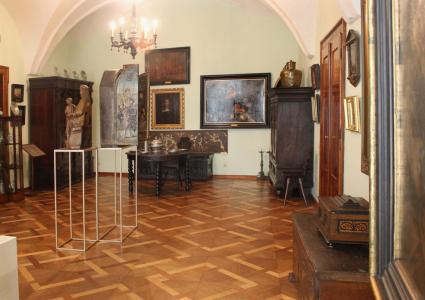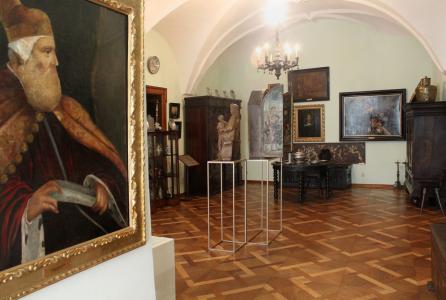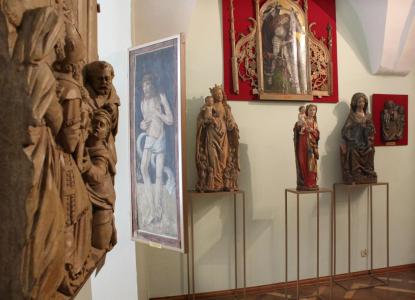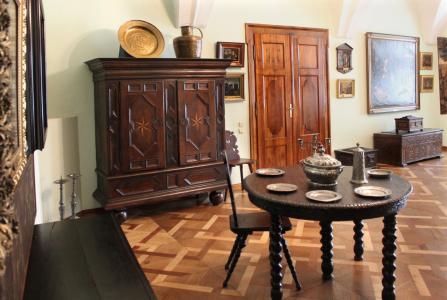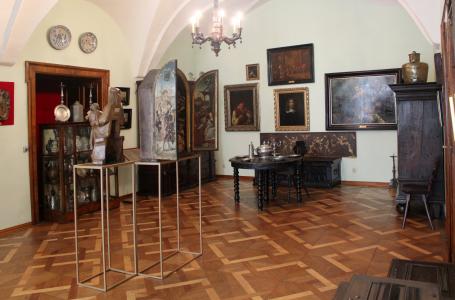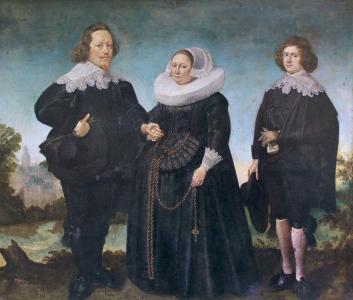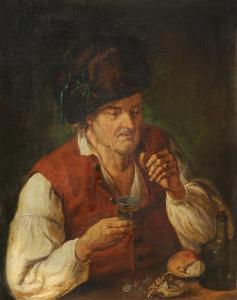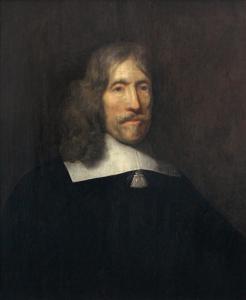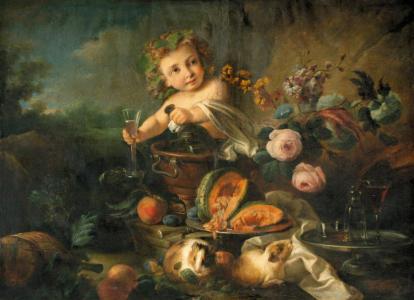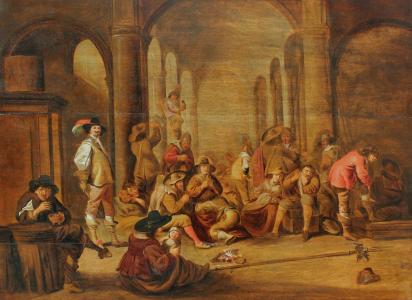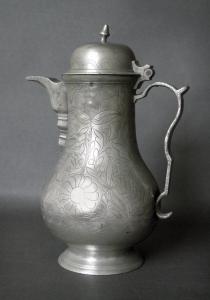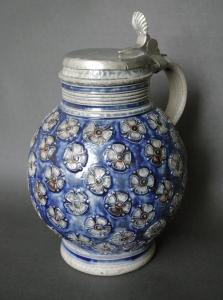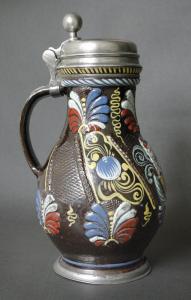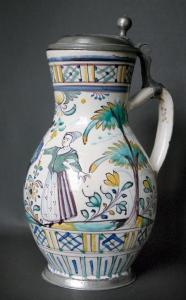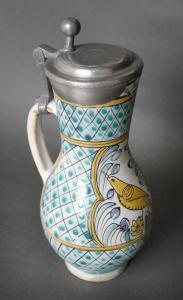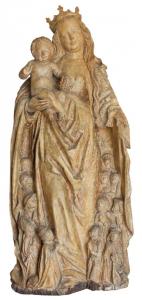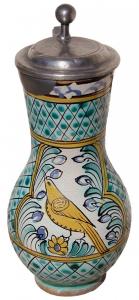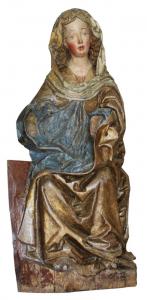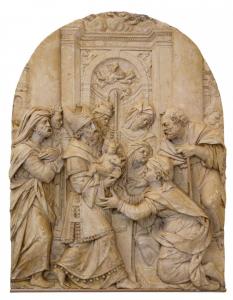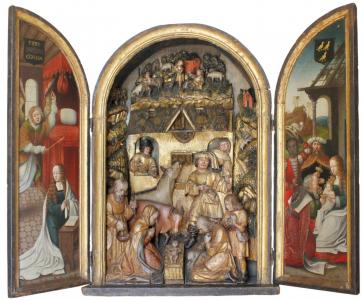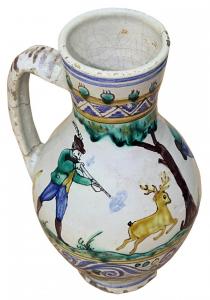Early Art Room
The arrangement of the permanent exhibition in the Sułkowski Dukes’ Castle, the main seat of the Historical Museum in Bielsko-Biała, apart from highlighting the various stages of its reconstruction, also accentuates the material legacy of its former times of splendour. This legacy includes the historical polychrome decorations which have undergone maintenance and reconstruction work; also the 19th century parquet floors, made up of large oak boards, with their beautiful geometric patterns, manufactured between 1818 and 1822 at Preiszler’s Parquet Flooring and Veneer Factory and which have embellished the west wing on the first floor since that time; and the wide, moulded architraves and doors decorated with moulded panels.
The artistic collections of the Museum in Bielsko have a multi-faceted dimension. This makes it possible to mount an attractive display of sculpture, paintings, furniture and items of broadly defined artisanal handicraft, created over the centuries. This includes the period from the end of the 14th century to mid-18th century. One of the rooms in the south wing on the first floor of the castle presents an exhibition of this early artwork. Among the exhibits on display, one can see various images of Saint Mary, in the form of the Madonna, the Mother of God, and the Intercessor. The figure of Madonna and Child with a Bird, from the end of the 14th century, is the oldest exhibit in the Museum in Bielsko. The style of the ‘Beautiful Madonnas’ is represented by a depiction of Saint Mary as part of the St Anne Trinitarian group; a painting on board showing Saint Anne from the same genre; also an iconographically elaborate image of the Madonna wearing a Mantle from the turn of the 16th century. A small, portable home altar was created in the form of a triptych around 1500 in the Antwerp Guild of St. Luke. This portrays the adoration of the shepherds in Bethlehem, and was carved in oak. Another triptych on display here was made in the Cracow workshop of Marcin Czarny, one of the pre-eminent artists of the late Middle Ages. The main central panel presents St. Michael the Archangel weighing a human soul, with an image of St Bartholomew on the obverse of one side panel and the Sorrowful Christ on the reverse.
During the period of the Renaissance there was a change of focus in art towards man, his interests and his immediate surroundings. Religious themes remained the main subject area, but the manner of their presentation changed. Elements of Renaissance imagery, visible above all else in the spatial composition of paintings or sculptures using different perspectives, can be observed in a picture of Christ before Pontius Pilate painted on board, also on a marble bas relief depicting the presentation of the infant Jesus in the temple and in a painting of 1622, entitled Reception at the Doge’s Palace.
The 17th century marks a clear division of Europe into two cultural areas – the northern and southern – defined by the social, political and religious changes of that time. The northern part of the continent is represented on the whole by Dutch and Flemish artists, mainly painting scenes of everyday life, such as On an Ice Rink. Landscapes were painted with naturalistic representations of household animals, e.g. Landscape with Cows and Goat, painted around 1650 in Paulus Potter’s studio. And there are also portraits of members of the town community. These depict individuals and groups and include the Portrait of Man in White Collar painted in 1659 by Frans Denys. Polish artist Teodor Lubieniecki also had an association with the Dutch circles, having learnt his artistry in Amsterdam. He painted Still life with Bacchus, on display in the exhibition. Peter Paul Rubens’ student, Frans Wouters also used mythological themes and is the artist of a small painting entitled Diana and Callisto.
The art of southern Europe is represented mainly by a single painting on canvas in the style of a Baroque mystery play, the Adoration of the Shepherds, by Genoese painter Gioacchino Assereto. Two small paintings on hardboard are from the first half of the 17th century: Clowns with a Ewer and Clowns – Knights, based on the works of French draftsman and chalcographer Jacques Callot, depicting couples of comedy dancers.
The paintings are complemented by 17th and 18th century examples of artisanal handicrafts. Special attention should be paid here to a late Renaissance wardrobe with architectonic features dating back to the first half of the 17th century, an oak chest decorated with an ‘H.W.’ monogram and a date of 1698, and a black chair with the Platers’ coat of arms engraved on its back. Also interesting are the wooden boxes (1674, 1733), guild coffers, in which such trade organizations would keep their most important documents and corporation seals.
Among the plethora of artisanal handicrafts on display in this room, of note is the wide range of pewter-made objects. These include plates, bowls, jars, ewers, mugs, flasks and candelabra, made by the dominant European pewtersmithing centres of Nuremberg, Württemberg, Chotéboř, Nysa, Lwówek Śląski, Głogów, Leipzig, Wrocław, Gdańsk and Cieszyn. The glass chalices and goblets displayed here were manufactured primarily in the Silesian glass-making centres. Of these, one worthy of closer attention is a chalice with an etched and polished scene from the second Silesian war waged by Prussia against the Austro-Saxon coalition. On the bowl of the chalice there is a portrayal of the Battle of Strzegom, better known as the battle of Hohenfriedberg or the Battle of Striegau. A rich collection of pottery includes mainly stoneware ewers with pewter lids and rims protecting the edges which were particularly prone to damage. These ewers were known as buncloki and were made in the workshops of Bolesławiec. There are also short-necked flasks decorated with mask-faces, created and painted around 1600 in a pottery centre near Cologne. Most of the earthenware ewers and mugs, decorated with botanic, animal, heraldic and figurative motifs, represent products made in pottery workshops operating in the 18th century in Silesia, Slovakia, Bohemia and Italy.
All these are complemented by stained glass windows with heraldic themes, acquired by the Museum directly from factory buildings on Leszczyńska St in Bielsko during the last century. These are associated with the family of Franciszek Strzygowski, one of the founders of the wool industry in our city.
(TDB)
